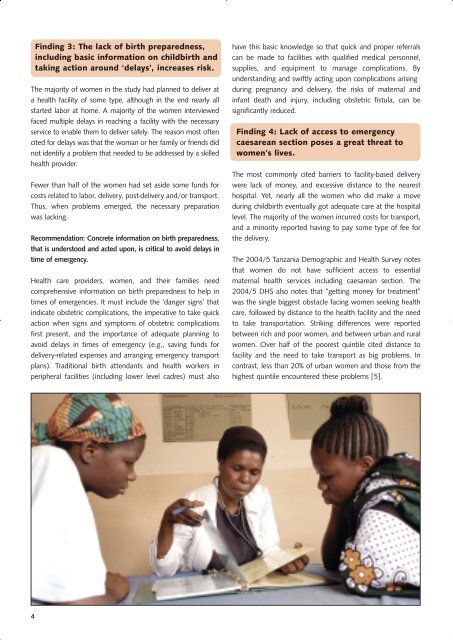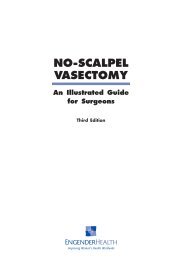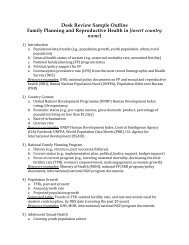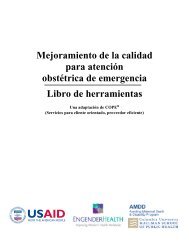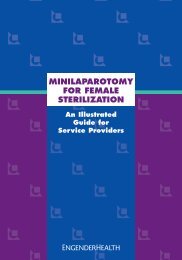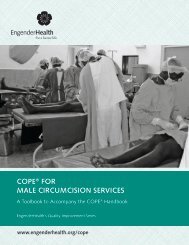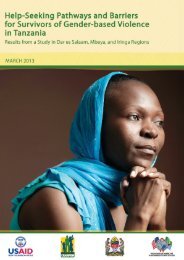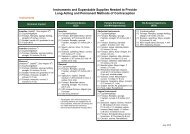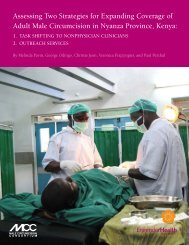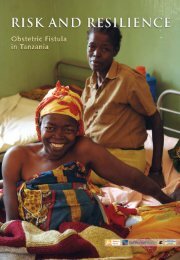Obstetric fistula in tanzania - EngenderHealth
Obstetric fistula in tanzania - EngenderHealth
Obstetric fistula in tanzania - EngenderHealth
You also want an ePaper? Increase the reach of your titles
YUMPU automatically turns print PDFs into web optimized ePapers that Google loves.
F<strong>in</strong>d<strong>in</strong>g 3: The lack of birth preparedness,<strong>in</strong>clud<strong>in</strong>g basic <strong>in</strong>formation on childbirth andtak<strong>in</strong>g action around ‘delays’, <strong>in</strong>creases risk.The majority of women <strong>in</strong> the study had planned to deliver ata health facility of some type, although <strong>in</strong> the end nearly allstarted labor at home. A majority of the women <strong>in</strong>terviewedfaced multiple delays <strong>in</strong> reach<strong>in</strong>g a facility with the necessaryservice to enable them to deliver safely. The reason most oftencited for delays was that the woman or her family or friends didnot identify a problem that needed to be addressed by a skilledhealth provider.Fewer than half of the women had set aside some funds forcosts related to labor, delivery, post-delivery and/or transport.Thus, when problems emerged, the necessary preparationwas lack<strong>in</strong>g.Recommendation: Concrete <strong>in</strong>formation on birth preparedness,that is understood and acted upon, is critical to avoid delays <strong>in</strong>time of emergency.Health care providers, women, and their families needcomprehensive <strong>in</strong>formation on birth preparedness to help <strong>in</strong>times of emergencies. It must <strong>in</strong>clude the ‘danger signs’ that<strong>in</strong>dicate obstetric complications, the imperative to take quickaction when signs and symptoms of obstetric complicationsfirst present, and the importance of adequate plann<strong>in</strong>g toavoid delays <strong>in</strong> times of emergency (e.g., sav<strong>in</strong>g funds fordelivery-related expenses and arrang<strong>in</strong>g emergency transportplans). Traditional birth attendants and health workers <strong>in</strong>peripheral facilities (<strong>in</strong>clud<strong>in</strong>g lower level cadres) must alsohave this basic knowledge so that quick and proper referralscan be made to facilities with qualified medical personnel,supplies, and equipment to manage complications. Byunderstand<strong>in</strong>g and swiftly act<strong>in</strong>g upon complications aris<strong>in</strong>gdur<strong>in</strong>g pregnancy and delivery, the risks of maternal and<strong>in</strong>fant death and <strong>in</strong>jury, <strong>in</strong>clud<strong>in</strong>g obstetric <strong>fistula</strong>, can besignificantly reduced.F<strong>in</strong>d<strong>in</strong>g 4: Lack of access to emergencycaesarean section poses a great threat towomen’s lives.The most commonly cited barriers to facility-based deliverywere lack of money, and excessive distance to the nearesthospital. Yet, nearly all the women who did make a movedur<strong>in</strong>g childbirth eventually got adequate care at the hospitallevel. The majority of the women <strong>in</strong>curred costs for transport,and a m<strong>in</strong>ority reported hav<strong>in</strong>g to pay some type of fee forthe delivery.The 2004/5 Tanzania Demographic and Health Survey notesthat women do not have sufficient access to essentialmaternal health services <strong>in</strong>clud<strong>in</strong>g caesarean section. The2004/5 DHS also notes that “gett<strong>in</strong>g money for treatment”was the s<strong>in</strong>gle biggest obstacle fac<strong>in</strong>g women seek<strong>in</strong>g healthcare, followed by distance to the health facility and the needto take transportation. Strik<strong>in</strong>g differences were reportedbetween rich and poor women, and between urban and ruralwomen. Over half of the poorest qu<strong>in</strong>tile cited distance tofacility and the need to take transport as big problems. Incontrast, less than 20% of urban women and those from thehighest qu<strong>in</strong>tile encountered these problems [5].4


